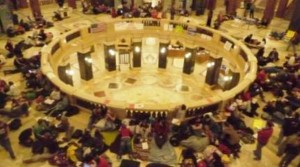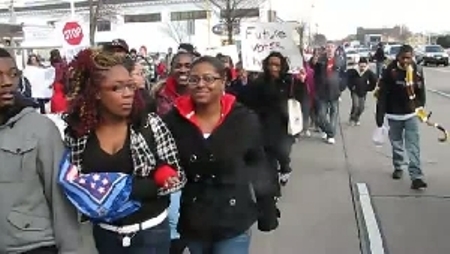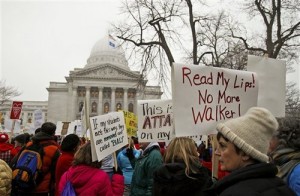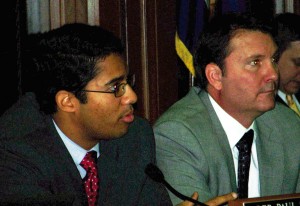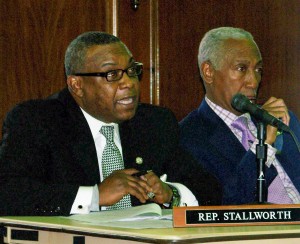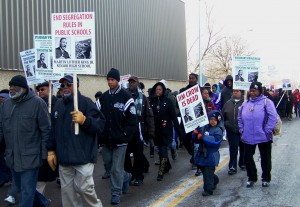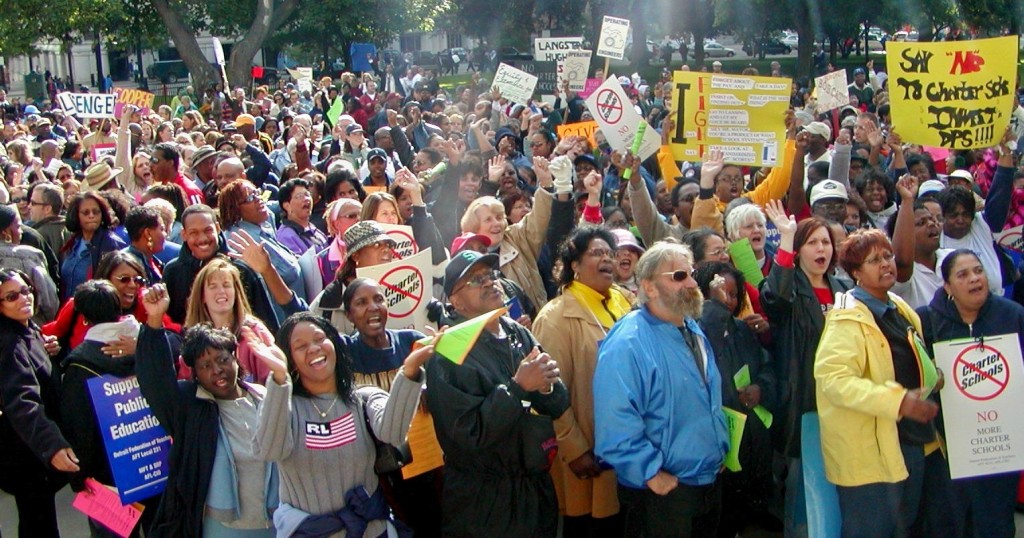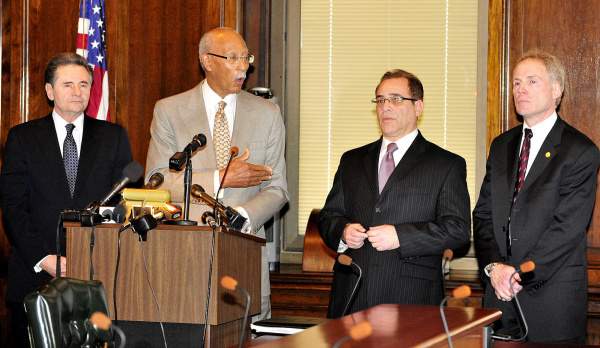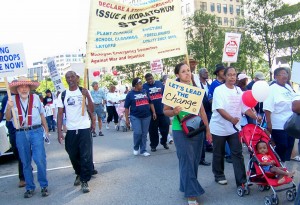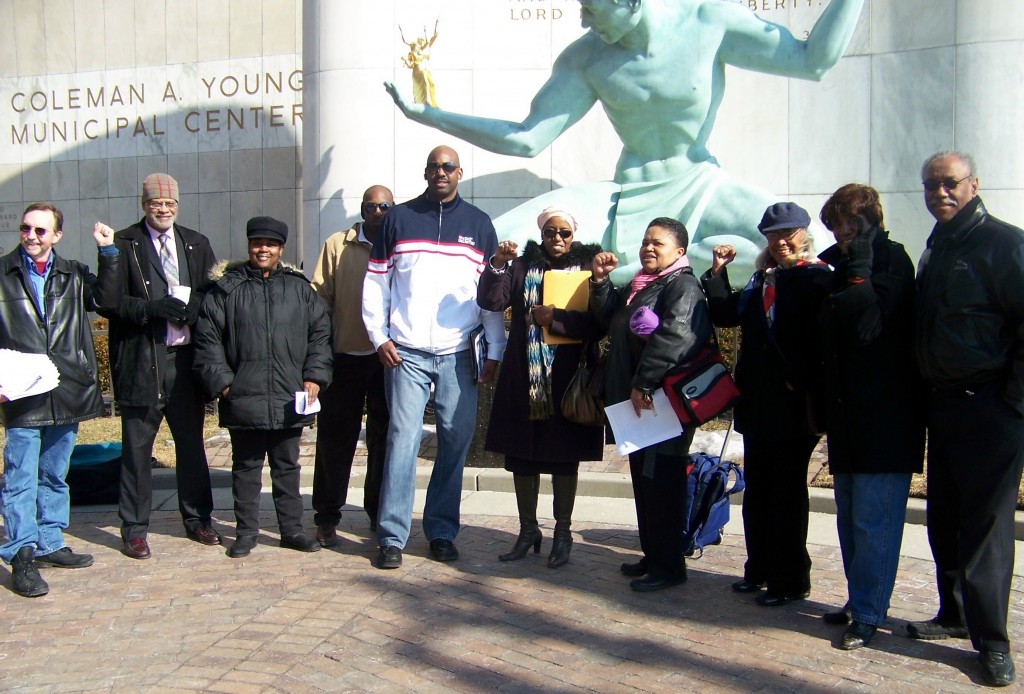
Detroit community leaders come together Feb. 16 to plan fightback
Legislature proposes sweeping powers for EFM’s, to pay off debt to banks
Breaking news: go to http://www.freep.com/article/20110131/NEWS15/110131028/State-tries-head-off-city-school-district-bankruptcies?odyssey=obinsite to read Free Press report that Gov. Snyder’s aide Andy Dillon is busy “training” 45 emergency financial managers with the expectation that they will be needed soon. Dillon said at least three to four cities are on the brink of receivership, but would not name them.
 According to a press release received by the VOD, Robert Bobb participated in a training session for EFM’s held Feb. 10, at the Henry Center for Executive Development at Michigan State University, 3535 Forest Road, Lansing. The release came from the Truscott Rossman Group, headed by former Governor John Engler’s press secretary and top aid John Truscott and newly founded on Dec. 22, 201o.
According to a press release received by the VOD, Robert Bobb participated in a training session for EFM’s held Feb. 10, at the Henry Center for Executive Development at Michigan State University, 3535 Forest Road, Lansing. The release came from the Truscott Rossman Group, headed by former Governor John Engler’s press secretary and top aid John Truscott and newly founded on Dec. 22, 201o.
By Diane Bukowski
LANSING and DETROIT, Feb. 16—“When are people going to wake up and realize we are in a class war?” asked Cecily McClellan, Vice-President of the city of Detroit’s Association of Professional and Technical Employees (APTE). “Our government now is nothing but a corporatocracy and it is in a full frontal attack against us.”
She and a dozen others gathered at the Spirit of Detroit statue outside the Coleman A. Young Center Feb. 16 to plan a fightback against multiple attacks on Detroit, including its water department.

Thousands mass in Wisconsin State Capitol Building Feb. 15 to stop war on workers and poor
Mike Mulholland, secretary-treasurer of AFSCME Local 207, representing Detroit Water Department workers, said, “We need to do what they are doing in Wisconsin. The teachers and students in Wisconsin have shut down the schools in response to the governor’s attacks. We do have the power and we can win.”
On Feb. 15, over 30,000 Wisconsin protesters took over the state capitol building, sleeping overnight in the rotunda.
Richard Hairston, a WHPR-TV commentator said, “This is Detroit’s Egyptian moment.”

Tina Person is interviewed by Channel 2's Amy Lange Feb. 16
Tina Person, also known as the Eastside Lady, said, “The bus drivers have said they will shut the buses down. We need to shut the whole city down, instead of Detroit 300 recruiting people to go out in the neighborhoods and attack people and send more of us to prison.”
Meanwhile, others from across the state journeyed to Lansing to testify at a hearing of the House Local, Intergovernmental and Regional Affairs Committee on House Bills 4124 through 4218. (Go to HB4214finanacialmanager2102011[1] to read lead bill).
While fightbacks across the Middle East, Africa and now Wisconsin are taking place, the Michigan Legislature is fast-tracking a bill that could abolish all constitutional and charter rights of local governments and school districts. It would instead give sweeping powers to Emergency Financial Managers (EFM’s) like Robert Bobb, while completely disenfranchising residents. (See summary of H.B. 4124 below. Go to HB4214finanacialmanager2102011[1] to read entire lead bill.)


State Rep. Al Pscholka (R-Stevensville, Berrien County)
State Rep. Al Pscholka, (R-Stevensville), introduced the bills Feb. 9. Committee Chair Ouimet (R-Scio Township) set them up for a hearing in record time with virtually no notice, and would not postpone discussion of amendments for one week as requested by State Rep. Woodrow Stanley (D-Flint). Meanwhile, three bills sponsored by State Rep. David Nathan (D-Detroit) that would limit EFM powers languish without a hearing. (Go to HB-4176-2011[1], HB-4177-2011[1], HB-4178-2011[1] to read those bills.)
Pscholka is a first-time legislator from Berrien County, former vice-president of the Cornerstone Alliance, a pro-privatization foundation, and former secretary to the Southwest Michigan Regional Sanitary Sewer and Water Authority.
He clearly has broad support from Republicans in the legislature and likely from Governor Rick Snyder, who was expected to announce sweeping cuts directed at working and poor Michiganders, including cities and school districts, in his budget address Feb. 17.
Over 50 people from Detroit, Flint, Pontiac and even wealthy Oakland County testified against Pscholka’s legislation Feb. 16. No one testified for it, although several politicians from Wayne County and Flint tried to turn the bills to their advantage.

Detroit City Councilwoman JoAnn Watson
Detroit City Councilwoman JoAnn Watson was the only Detroit City Council member to make the trip. Mayor Dave Bing did not show his face. He has said he and Snyder are “joined at the hip.”
“I urge the committee to vote down these bills that would harm the city of Detroit, and not subject citizens across Michigan to emergency control managers who are business persons not elected by people we represent,” Watson said.
She blasted the state of Michigan for causing Detroit’s financial problems in large part by legislation that phased down the city’s income tax while promising to increase state revenue sharing. The state never held up its end of the bargain, paying increased payments in only two years from 1999 to 2007.
Snyder, meanwhile, is proposing to cut state revenue-sharing payments to cities by 33 percent according to published reports.
“The state owes Detroit over $322 million in revenue sharing funds,” Watson said. “We would not be in a deficit and subject to receivership under this legislation if Michigan had paid its bill.”

Debra Taylor testifies at committee hearing in Lansing Feb. 16
Debra Taylor of the Southeast Detroit Citizens District Council said, “These bills violate our fundamental right to govern ourselves. This is taxation without representation. They are a direct attack on African-Americans and other people of color, and all low income people. Detroit, Pontiac, Benton Harbor, Flint, we are targeted first. Slavery was legal but it wasn’t right. Hundreds of schools have been closed by our EFM. People are feeling repressed and relating to Egypt. What you’re doing is not democratic or fair.”
State Rep. Shanelle Jackson (D-Detroit), told the committee, “We watched the fall of Mubarak, and the U.S. and nations around the world have said they stand with people of Egypt in their quest for democracy. Today, I’m asking you to stand with the people of Michigan. These bills are a slap in the face of every voter who elected you.”
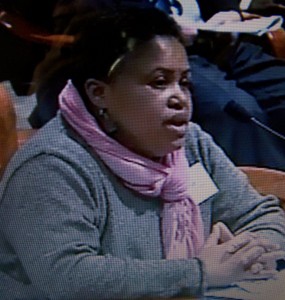
Monica Patrick testifies in Lansing Feb. 16
Detroit parent and business owner Monica Patrick said, “I am outraged that these bills are on the table. I am not only a citizen of city of Detroit, but of Michigan and the United States. It is appalling that anyone would think of stripping us of our right to vote while we tout democracy around the world. It is not acceptable and will not be tolerated. I will fight this action with every ounce of my being.”
Officials from school districts and governments currently under state control testified strongly against the bill.
“In 1999, the district did not have a deficit but the state took us over and brought the debt in,” said Detroit School Board member Annie Carter. “In 2008, Detroiters voted to have the state forgive the debt they caused, but that did not happen. When you give control to one czar, you create corruption. My child’s school has gone eight days with no heat because Bobb laid the boiler operators off and Sodexo will not have anyone in place for 30 days. Our children are being educated in the cold and then going home to the cold because their parents cannot afford utility bills. Teachers are being moved in the middle of the semester, and as a result students are not being educated.”
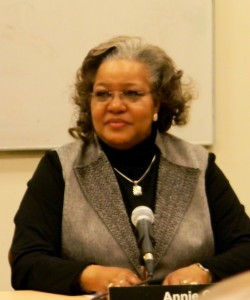
DPS Board Member Annie Carter
Detroit School Board member Terry Catchings called the bills “totally, clearly unconstitutional.”
“I have been on the board for three years, with the last two under the control of the EFM. Since he took over, there is no accountability and no oversight. Our budget deficit went up over $200 million in two years. Confusion, waste, fraud and abuse abound. These bills will harm not just Detroit but other districts in deficit also.”
Forty-one school districts across the state are in deficit.
“Our entire educational system is in an abysmal state,” Detroit parent Sharon Kelso said. “There is complete degradation and disregard of parents, students and staff, Bobb has all but destroyed the public education system. My child hasn’t learned jack in the last two years.”
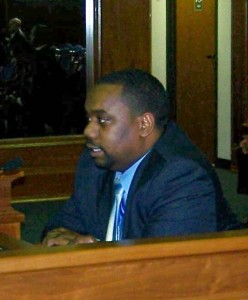
State Rep. David Nathan testifies at earlier hearing Feb. 9 in Lansing
Rep. David Nathan (D-Detroit) said. “I sat on the education committee during my first term. Academics from the University of Detroit Mercy, Wayne State, Michigan State and the University of Michigan all concluded that an emergency financial manager doesn’t necessarily have the expertise to deal with academics.”
Nathan said the former EFM for Pontiac was removed and lost lawsuits on decisions he had made because there was no oversight.
“These bills will affect more cities and schools in our state than we can ever imagine,” Nathan said. “There are pension systems that could be affected by this. I urge all of my colleagues on both sides of aisle to think about the people that elected you and things that could be affected.”
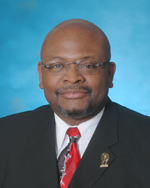
Pontiac City Council President Lee A. Jones

Pontiac Councilman Kermit Williams
The City of Pontiac has been under state receivership since March, 2009. A second EFM is in control after the first was ousted due to successful lawsuits over his illegal actions. Pontiac’s City Council President Lee Jones, and members George Williams, Kerwin Williams, and Patrice Waterman all testified before the committee.
“How many of you on this committee live under an EFM,” President Jones asked. “Our constitutional rights have been violated. There has been union-busting, a total dictatorship. The EFM shut down city council meetings, silencing the voice of the people as his first order of business, but then two days later he had to put them back.”
The council members said the EFM has caused substantial revenue losses to the city. He sold the Silverdome for $500,000, although $7 million was allocated. He privatized Pontiac’s wastewater treatment plant, sold the golf course, and carried out massive lay-offs and cuts, said the council members. They said the EFM has laid of the entire police force, allocating funds for the Oakland County Sheriffs instead.
Jones said the EFM let a contract to a non-Michigan based company and commented, “They done worked for me in the past, I done it, and that’s what I wanted to do.”
He said he sent letters to the EFM protesting lay-offs and was referred to the law firm of Plunkett and Cooney, which told him he was interfering with the powers of the EFM.
“If I pick up phone and contact a law firm, the first thing they do is start billing, and that’s something we can’t afford,” Jones said. “EFM’s are for money to law firms, their friends and themselves.”
The Pontiac council members said they have no staff, and when they asked for money to hire one secretary to answer the phone, the EFM asked them to have the secretary work for nothing.
Councilman Kermit Williams said, “The law is clandestine, undercover, this is not the way to keep cities from being bankrupt. I don’t wish an EFM on anybody. Pontiac lost 25,000 jobs in the last 10 years, and we only have 60,000 residents. If you want
to change the EFM law, look at a financial plan to make sure that the EFM not only cuts but brings revenue in. Our EFM got rid of revenue generators like the Planning and Buildings and Safety Department, so now when businesses want to locate in Pontiac, they have no one to go to.”

Pontiac retiree testifies in Lansing
A Pontiac city retiree who previously was director of public works said, “I worked 42 years for city of Pontiac, and I don’t like waking up and thinking I won’t have retirement or a pension. That is the only thing left in Pontiac that has a little money, and he wants to get to that. He wants to dissolve the pension board. If you allow this to happen, don’t wake up in the morning and think about your own pension or your Social Security.”
Testimony against the bills also came from an area not likely to be affected by them.
“Oakland County has a triple A bond rating,” said Oakland County Commissioner Tim Greimel. “But I have great concerns about the policy implications of this legislation. It shouldn’t be a partisan issue. Although many communities currently under EFM’s are predominantly Democratic, there are a number of predominantly Republican committees that could be ensnared.”

Oakland Co. Commissioner Tim Greimel
He continued, “The bills leaves far too much authority in the hands of individuals without discretion as to what constitutes financial emergency. They completely and unequivocally disenfranchise voters by taking away all powers from elected officials. They allow EFM’s to unilaterally and directly contradict charters, the will of the people at the ballot box. They burden local governments with consequences of decisions they did not make. They force local governments to pay the attorney general to defend the EFM against constitutional challenges and would require local governments and their taxpayers to pay for defense of civil and criminal proceedings against EFM. In communities slipping into financial distress, this would actually accelerate the distress.”
Greimel said businesses will be unlikely to locate in affected areas knowing that the EFM can alter or rescind their contracts.
“Unions will be very unlikely to make concessions because they know can easily get racked up again by the EFM. The bill allows the EFM to essentially bribe local elected officials to buy compliance, by giving the EFM carte blanche to adjust salaries of elected officials. It thus violates their constitutional right to free speech and leaves the state open to lawsuit. It means a massive expansion of government and a new bureaucratic class with no guarantee that it will not overstep legal and ethical bounds.”
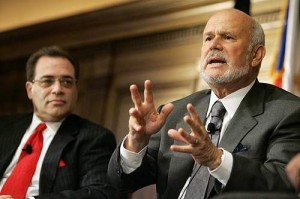
Wayne Co. Exec. Robert Ficano listens as Compuware's Peter Karmanos rails against unions in 2007
While ostensibly speaking against the bills, Wayne Co. Executive Robert Ficano’s representative and Flint Mayor Dayne Walling sought amendments to give the draconian powers they accord to EFM’s to local heads of government instead.
“The powers granted to the EFM should be granted directly to elected officials,” Jerry Griffin, Ficano’s director of legislative affairs, said. “If there is a financial emergency and there are powers needed to address it, give us the powers. The challenges out there were not necessarily caused by incompetence or the negligence of local officials. Sixty percent of our revenues come from property taxes, and the decline in the housing market has caused great stresses.”
Walling said, “I appreciate the parts of bill that will allow local officials to have more authority prior to going to an EFM.”
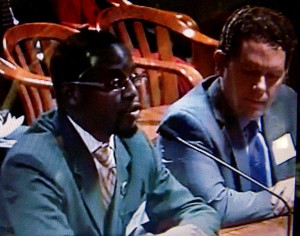
Flint City Councilman Delrico Lloyd and Flint Mayor
He and current Flint Councilman Delrico Lloyd both objected to a provision in the bill that originally prevented elected officials serving under receivership from running for office again for 10 years. Ouimet said that had been changed to 18 months.
The committee continued meeting to discuss numerous proposed amendments to the bills, which at press time had not been published on the state website.
(More coming from Feb. 9 meeting in Lansing, including comments from Helen Moore, Russ Bellant, David Nathan.)


